Professor Layton and the Diabolical Box/Lost in Translation
This is a sub-page of Professor Layton and the Diabolical Box.
| This page or section needs more images. There's a whole lotta words here, but not enough pictures. Please fix this. |
| To do: *More differences between puzzles can be found here. |
Note: The Korean version uses the same puzzles as the European version, with the exception of Puzzle 30 where it uses the same puzzle as the JP/US version.
This page details regional differences for Professor Layton 2.
Puzzles Changed in the US Version
Puzzle 7: The US version asks where a particular person is sitting based on hints. The JP version has instead a numerical puzzle:
As shown by the map, there are four tables for four people, seating a total of 16. For all the guests, either next or opposite them is seated someone of the opposite sex. If there are less men, what is the minimum number of men required to fill the restaurant? Remember that there is a path that runs between the tables, seats on either side of the path are still "next" to each other.
Puzzle 8: The US version has a numerical puzzle where we must find out what did Luke order for dinner based on some hints. It was slightly modified over the JP version, possibly because of alcohol references:
Written on the menu is: "For the people travelling, we charge a 20% service charge". Luke and Layton had one drink each, and each had at least one thing to eat. They didn't order anything more than once, and the bill was exactly $60. Tick the things they ordered on the menu below. Of course, Luke doesn't drink alcohol. The menu:
DRINKS: Orange Juice : $4 | Apple Juice : $5 | Beer: $13 | Red Wine: $21 | White Wine: $24 |
MEALS: Sandwich: $12 | Potato Salad: $11| Soup : $16 | Spaghetti: $18 | Roast Beef : $35 |
Puzzle 11: The US version has a forest to divide to four zones each with one tree. The JP version has instead the following puzzle:
From the window of the train, the scenery moves in three different speeds. From fastest to slowest: foreground, middle ground and background. However, at one point, the direction of the scenery changes, and the middle ground barely moves. Where is this point?
Puzzle 28: The US version asks which of the given patterns are given by the axle of a moving wheel. The JP version similarly deals with unconventional wheels:
The figure shown below on the right is known as a Reuleaux triangle. Like shown, it is an equilateral triangle with its sides rounded. This shape, like a circle, has a width (diameter) that is the same from each side. Therefore, if used as a wheel, the height of the object it is holding up will not change as long as the surface it rolls on is flat. Which shapes out of the following will have similar properties to the Reuleaux triangle?
Puzzle 36: A bird fell in a hole, and you must save him! Only in the US version, you have to help him go through an underground maze.
In the JP one, you are told to use something commonly found in a park to help him go out, knowing that the hole is deep and curved, so you cannot reach down to the bottom by hand. Also, the surface is hard, so you cannot make the hole bigger. You have to type the answer in hiragana.
Oddly enough, the JP variant was translated in the US release! There is an unused puzzle in the US version, which is an exact English translation of the JP variant of this puzzle, under the name “Bird in a Hole”. The answer is inputted with four English letters, and is the same as the JP one, only translated. It is unknown why they removed it even from the US version.
Puzzle 56: You must find out the door’s code. In the US version, you have to rearrange cards with geometrical shapes in the correct order.
In the JP version, you have to rotate and rearrange the given numbers to form a message: 3 3 3 3 0 0 7
Puzzle 65: In the US version you have to decrypt a treasure map. In the JP version, you have to summarize an over-lengthy coded war message (It roughly means “We have lost”).
Puzzle 68: Layton is told : “Leave your hat here”, but he isn’t quite willing to oblige, due to reasons revealed in the sequel. In the US version, the “hat” he leaves is a simple outline that must be found in a confusing pattern.
The JP version is by far the most interesting: You must flip the other hats to form the English word for “HAT”.
Puzzle 75: The US replacement puzzle is very similar to the Puzzle 11 one. The Japanese version is, once again, a numerical puzzle:
There are 3 boxes, and in each box, there are 2 pastries. A box with 2 cookies, a box with a cookie and a candy, and a box with 2 candies. When I closed my eyes and took one thing, it was a cookie. How many times larger is the possibility that the other pastry remaining in the box is a cookie rather than a candy?
The US version has an unused puzzle which is an English translation of the JP variant of this puzzle.
Puzzle 82: In the US version, you must connect the wires to fix the puzzle. The JP puzzle is pun-based: “Look carefully and press the button to unlock the exit”, where the answer is a 5 that seen sideways looks like the word "out".
Puzzle 94: Eight small identical cubes have been combined to form a larger one. In the US version, you are asked which letter is on the highlighted face.
The JP version has you instead find out where the point X is, knowing that if the length of PA was 1 unit, and PB was 2 units, then the X point on the cube will be 3 units away from P. Of course when talking about length, we mean in straight lines.
Puzzle 96: The US version asks from which one of the shown wood slabs was cut the “ghost” wooden figure. The JP version has instead you find the hidden message about a monster behind the piece of paper enclosed with the hinotama (fireball ghost) photos. The solution is… “Just kidding”.
Puzzle 145: A numerical puzzle about pearls in the US version, this was originally about dates in the JP version, that was excessively easy for a 70-picarat puzzle:
Writing the date is different depending on the country. For example, for March 5th, in America, it is written as "3.5", but in Britain and many parts of Europe, it is written as "5.3". That way, it is hard to distinguish whether they were trying to write March 5th or May 3rd. Now then, in one year, how many times does this occur?
Puzzles Changed in the EU Version
Puzzle 30: While the JP and US versions have the fountain form a vertically-symmetrical English word which must be entered as a solution, the European version has a date instead of a word.
| North America | Europe |
|---|---|
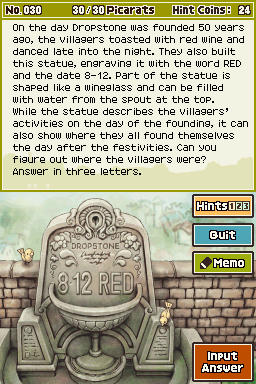
|
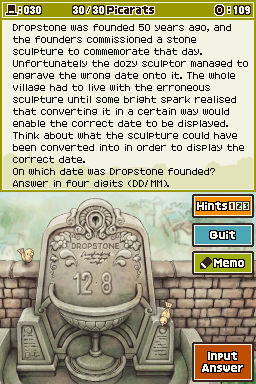
|
Puzzle 52: Albeit the puzzle is the same type in both versions, there are some alterations in the European version about the solution.
| North America | Europe |
|---|---|
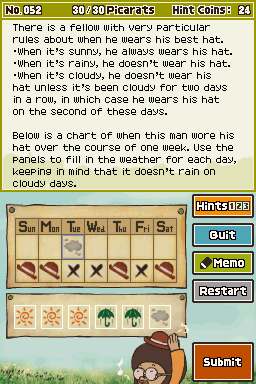
|
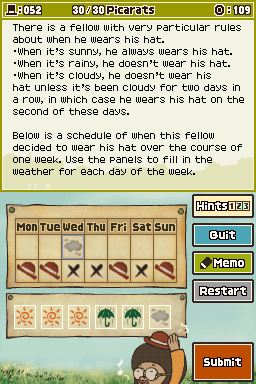
|
Puzzle 139: The puzzle description in the US version contains an error: it claims that New York's timezone is three hours behind Los Angeles', when it should be the other way around. The EU version corrects this.
| North America | Europe |
|---|---|
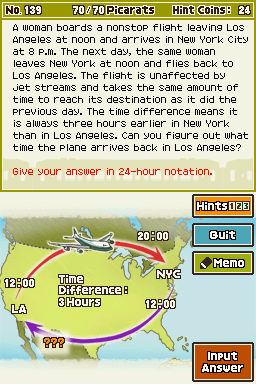
|
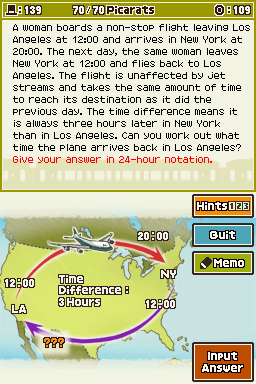
|
Wi-Fi Puzzles
| This needs some investigation. Discuss ideas and findings on the talk page. Specifically: Everything! |
The Wi-Fi puzzles are mostly different between the JP and US versions.